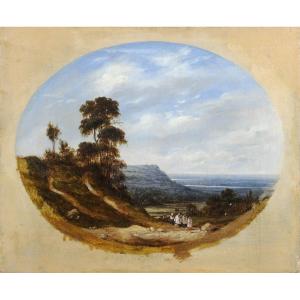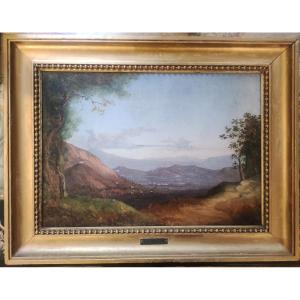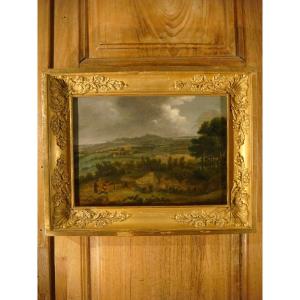(Malines, 1795 – Venice, 1872)
Venice, the rear of the Saint Roch church and the Frari campanile
Oil on canvas
39 x 32 cm
Traces of signature lower right
We had, from the start , thought of Frans Vervloet as the possible author of this painting of very high quality, whose rendering, with an asserted sensitivity, of the light and the play of shadows, the very precise workmanship of the architecture and vegetation, and the general atmosphere are also characteristic of Nordic painters. The two figures, and in particular the young man in the Nordic cap resting against the well, are executed with marked attention to detail. It is precisely this great meticulousness, even dryness, which made us be cautious about attributing it to Frans Vervloet. But the recent appearance on the market of a small watercolor by his son, signed J. Vervloet junior and dated 1880, using the same composition as our canvas, confirms our first idea. Frans Vervloet is the most famous Belgian vedutist of the 19th century. After initial training in his hometown with Frans de Noter, he traveled through Belgium and the Netherlands and produced numerous church interiors. Following a short stay in Paris, he discovered Italy in 1822, with Rome and its surroundings as his home port. In 1824, he moved to Naples, where he became one of the main representatives of the so-called Pausilippus school with his friend Pitloo. He returned from time to time to Rome, discovering Constantinople, Malta, and especially Venice from 1834. Vervloet settled definitively in the city of the Doges in 1854. It was there that his style became more strict and very analytical, in the tradition views of Canaletto a century earlier. Posted in the campiello de le Chiovere (named after the place where the dyed sheets were dried) in the historic district of San Polo, the artist represents the rear of the Saint Roch church, with its campanile, its apse, as well as two statues adorning the top of the facade. The other bell tower is that of the Frari church; it seems to be one with the Saint Roch church even though it is located a few dozen meters further. The place has changed very little, with the exception of the back wall of the composition, which was destroyed after the First World War, in order to open a path (Calle Tintoretto) to Campo San Rocco; the side street is named Calle San Nicoleto. The construction of the well, made of Istrian stone, dates back to the 14th/15th centuries.


































 Le Magazine de PROANTIC
Le Magazine de PROANTIC TRÉSORS Magazine
TRÉSORS Magazine Rivista Artiquariato
Rivista Artiquariato